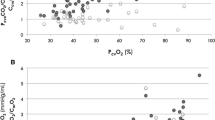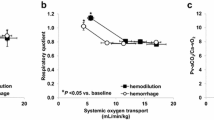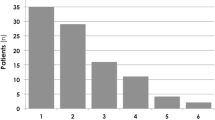Abstract
Circulatory shock is common among patients admitted to the intensive care unit and, despite improved medical management, remains associated with a high mortality rate. Under these circumstances, tissue perfusion and cellular oxygenation are commonly assessed by blood lactate and venous oxygen saturation (SvO2). Venous-to-arterial difference in CO2 partial pressure (Pv-aCO2 gap) is another parameter, which can easily be obtained (through simultaneous sampling of central or mixed venous and arterial blood) and appears to have prognostic abilities in several types of shock. The Pv-aCO2 gap can provide insight into the adequacy of cardiac output relative to oxygen consumption and represents a link between the macro- and microcirculation. Correct interpretation of the Pv-aCO2 gap at the bedside, however, requires an understanding of CO2 physiology and of elements modulating the relationship between CO2 content and its partial pressure (Haldane effect, acidosis, anemia...). In this chapter, we review the physiological basis underlying CO2 production, transport and blood content, as well as the clinical implications of an increased Pv-aCO2 gap. We review the evidence linking Pv-aCO2 gap to clinical outcomes and, finally, we propose algorithms guiding the interpretation of Pv-aCO2 in different types of dysoxia.
Access this chapter
Tax calculation will be finalised at checkout
Purchases are for personal use only
Similar content being viewed by others
References
Gavelli F, Teboul JL, Monnet X. How can CO2-derived indices guide resuscitation in critically ill patients? J Thorac Dis. 2019;11(Suppl 11):S1528–S37.
Geers C, Gros G. Carbon dioxide transport and carbonic anhydrase in blood and muscle. Physiol Rev. 2000;80:681–715.
Douglas AR, Jones NL, Reed JW. Calculation of whole blood CO2 content. J Appl Physiol. 1988;65:473–7.
Dash RK, Bassingthwaighte JB. Blood HbO2 and HbCO2 dissociation curves at varied O2, CO2, pH, 2,3-DPG and temperature levels. Ann Biomed Eng. 2004;32:1676–93.
Dres M, Monnet X, Teboul JL. Hemodynamic management of cardiovascular failure by using PCO(2) venous-arterial difference. J Clin Monitor Comput. 2012;26:367–74.
van Beest PA, Lont MC, Holman ND, Loef B, Kuiper MA, Boerma EC. Central venous-arterial pCO(2) difference as a tool in resuscitation of septic patients. Intensive Care Med. 2013;39:1034–9.
Zhang H, Vincent JL. Arteriovenous differences in PCO2 and pH are good indicators of critical hypoperfusion. Am Rev Respir Dis. 1993;148:867–71.
Teboul JL, Mercat A, Lenique F, Berton C, Richard C. Value of the venous-arterial PCO2 gradient to reflect the oxygen supply to demand in humans: effects of dobutamine. Crit Care Med. 1998;26:1007–10.
Denault A, Guimond JG. Does measuring veno-arterial carbon dioxide difference compare to predicting a hockey game's final score? Can J Anesthesia. 2021;68:445–53.
Hayes MA, Timmins AC, Yau EH, Palazzo M, Hinds CJ, Watson D. Elevation of systemic oxygen delivery in the treatment of critically ill patients. N Engl J Med. 1994;330:1717–22.
Robin E, Futier E, Pires O, Fleyfel M, Tavernier B, Lebuffe G, et al. Central venous-to-arterial carbon dioxide difference as a prognostic tool in high-risk surgical patients. Crit Care. 2015;19:227.
Monnet X, Julien F, Ait-Hamou N, Lequoy M, Gosset C, Jozwiak M, et al. Lactate and venoarterial carbon dioxide difference/arterial-venous oxygen difference ratio, but not central venous oxygen saturation, predict increase in oxygen consumption in fluid responders. Crit Care Med. 2013;41:1412–20.
Ducrocq N, Kimmoun A, Levy B. Lactate or ScvO2 as an endpoint in resuscitation of shock states? Minerva Anestesiol. 2013;79:1049–58.
Groeneveld AB. Interpreting the venous-arterial PCO2 difference. Crit Care Med. 1998;26:979–80.
Vallet B, Teboul JL, Cain S, Curtis S. Venoarterial CO(2) difference during regional ischemic or hypoxic hypoxia. J Appl Physiol. 2000;89:1317–21.
Neviere R, Chagnon JL, Teboul JL, Vallet B, Wattel F. Small intestine intramucosal PCO(2) and microvascular blood flow during hypoxic and ischemic hypoxia. Crit Care Med. 2002;30:379–84.
Dubin A, Estenssoro E, Murias G, Pozo MO, Sottile JP, Baran M, et al. Intramucosal-arterial Pco2 gradient does not reflect intestinal dysoxia in anemic hypoxia. J Trauma. 2004;57:1211–7.
Ferrara G, Kanoore Edul VS, Martins E, Canales HS, Canullan C, Murias G, et al. Intestinal and sublingual microcirculation are more severely compromised in hemodilution than in hemorrhage. J Appl Physiol. 2016;120:1132–40.
Liaudet L, Oddo M. Role of poly(adenosine diphosphate-ribose) polymerase 1 in septic peritonitis. Curr Opin Crit Care. 2003;9:152–8.
Fink MP. Cytopathic hypoxia and sepsis: is mitochondrial dysfunction pathophysiologically important or just an epiphenomenon. Pediatr Crit Care Med. 2015;16:89–91.
Mik EG, Balestra GM, Harms FA. Monitoring mitochondrial PO2: the next step. Curr Opin Crit Care. 2020;26:289–95.
Andreis DT, Mallat J, Tettamanti M, Chiarla C, Giovannini I, Gatti S, et al. Increased ratio of P[v-a]CO2 to C[a-v]O2 without global hypoxia: the case of metformin-induced lactic acidosis. Respir Physiol Neurobiol. 2021;285:103586.
Waldauf P, Jiroutkova K, Duska F. Using pCO2 Gap in the differential diagnosis of hyperlactatemia outside the context of sepsis: a physiological review and case series. Crit Care Res Pract. 2019;2019:5364503.
Bakker J, Vincent JL, Gris P, Leon M, Coffernils M, Kahn RJ. Veno-arterial carbon dioxide gradient in human septic shock. Chest. 1992;101:509–15.
Mecher CE, Rackow EC, Astiz ME, Weil MH. Venous hypercarbia associated with severe sepsis and systemic hypoperfusion. Crit Care Med. 1990;18:585–9.
Vallee F, Vallet B, Mathe O, Parraguette J, Mari A, Silva S, et al. Central venous-to-arterial carbon dioxide difference: an additional target for goal-directed therapy in septic shock? Intensive Care Med. 2008;34:2218–25.
Ospina-Tascon GA, Bautista-Rincon DF, Umana M, Tafur JD, Gutierrez A, Garcia AF, et al. Persistently high venous-to-arterial carbon dioxide differences during early resuscitation are associated with poor outcomes in septic shock. Crit Care. 2013;17:R294.
De Backer D, Donadello K, Sakr Y, Ospina-Tascon G, Salgado D, Scolletta S, et al. Microcirculatory alterations in patients with severe sepsis: impact of time of assessment and relationship with outcome. Crit Care Med. 2013;41:791–9.
Revelly JP, Liaudet L, Frascarolo P, Joseph JM, Martinet O, Markert M. Effects of norepinephrine on the distribution of intestinal blood flow and tissue adenosine triphosphate content in endotoxic shock. Crit Care Med. 2000;28:2500–6.
De Backer D, Creteur J, Preiser JC, Dubois MJ, Vincent JL. Microvascular blood flow is altered in patients with sepsis. Am J Respir Crit Care Med. 2002;166:98–104.
Creteur J, De Backer D, Sakr Y, Koch M, Vincent JL. Sublingual capnometry tracks microcirculatory changes in septic patients. Intensive Care Med. 2006;32:516–23.
Ospina-Tascon GA, Umana M, Bermudez WF, Bautista-Rincon DF, Valencia JD, Madrinan HJ, et al. Can venous-to-arterial carbon dioxide differences reflect microcirculatory alterations in patients with septic shock? Intensive Care Med. 2016;42:211–21.
De Backer D. Is microcirculatory assessment ready for regular use in clinical practice? Curr Opin Crit Care. 2019;25:280–4.
Teboul JL, Saugel B, Cecconi M, De Backer D, Hofer CK, Monnet X, et al. Less invasive hemodynamic monitoring in critically ill patients. Intensive Care Med. 2016;42:1350–9.
Mallat J, Pepy F, Lemyze M, Gasan G, Vangrunderbeeck N, Tronchon L, et al. Central venous-to-arterial carbon dioxide partial pressure difference in early resuscitation from septic shock: a prospective observational study. Eur J Anaesthesiol. 2014;31:371–80.
Vallet B, Pinsky MR, Cecconi M. Resuscitation of patients with septic shock: please "mind the gap"! Intensive Care Med. 2013;39:1653–5.
Al Duhailib Z, Hegazy AF, Lalli R, Fiorini K, Priestap F, Iansavichene A, et al. The use of central venous to arterial carbon dioxide tension gap for outcome prediction in critically ill patients: a systematic review and meta-analysis. Crit Care Med. 2020;48:1855–61.
Diaztagle Fernandez JJ, Rodriguez Murcia JC, Sprockel Diaz JJ. Venous-to-arterial carbon dioxide difference in the resuscitation of patients with severe sepsis and septic shock: A systematic review. Med Intensiva. 2017;41:401–10.
Mukai A, Suehiro K, Kimura A, Funai Y, Matsuura T, Tanaka K, et al. Comparison of the venous-arterial CO2 to arterial-venous O2 content difference ratio with the venous-arterial CO2 gradient for the predictability of adverse outcomes after cardiac surgery. J Clin Monitor Comput. 2020;34:41–53.
Zante B, Reichenspurner H, Kubik M, Schefold JC, Kluge S. Increased admission central venous-arterial CO2 difference predicts ICU-mortality in adult cardiac surgery patients. Heart Lung. 2019;48:421–7.
Huette P, Beyls C, Mallat J, Martineau L, Besserve P, Haye G, et al. Central venous-to-arterial CO2 difference is a poor tool to predict adverse outcomes after cardiac surgery: a retrospective study. Can J Anaesth. 2021;68:467–76.
Mazzeffi M, Zivot J, Buchman T, Halkos M. In-hospital mortality after cardiac surgery: patient characteristics, timing, and association with postoperative length of intensive care unit and hospital stay. Ann Thorac Surg. 2014;97:1220–5.
Mallat J, Lemyze M, Tronchon L, Vallet B, Thevenin D. Use of venous-to-arterial carbon dioxide tension difference to guide resuscitation therapy in septic shock. World J Crit Care Med. 2016;5:47–56.
Saludes P, Proenca L, Gruartmoner G, Ensenat L, Perez-Madrigal A, Espinal C, et al. Central venous-to-arterial carbon dioxide difference and the effect of venous hyperoxia: A limiting factor, or an additional marker of severity in shock? J Clin Monitor Comput. 2017;31:1203–11.
Orbegozo Cortes D, Puflea F, Donadello K, Taccone FS, Gottin L, Creteur J, et al. Normobaric hyperoxia alters the microcirculation in healthy volunteers. Microvasc Res. 2015;98:23–8.
Mallat J, Mohammad U, Lemyze M, Meddour M, Jonard M, Pepy F, et al. Acute hyperventilation increases the central venous-to-arterial PCO2 difference in stable septic shock patients. Ann Intensive Care. 2017;7:31.
Author information
Authors and Affiliations
Corresponding author
Editor information
Editors and Affiliations
Rights and permissions
Copyright information
© 2021 The Author(s), under exclusive license to Springer Nature Switzerland AG
About this chapter
Cite this chapter
Ltaief, Z., Schneider, A.G., Liaudet, L. (2021). Pathophysiology and Clinical Implications of the Veno-arterial PCO2 Gap. In: Vincent, JL. (eds) Annual Update in Intensive Care and Emergency Medicine 2021. Annual Update in Intensive Care and Emergency Medicine. Springer, Cham. https://doi.org/10.1007/978-3-030-73231-8_8
Download citation
DOI: https://doi.org/10.1007/978-3-030-73231-8_8
Published:
Publisher Name: Springer, Cham
Print ISBN: 978-3-030-73230-1
Online ISBN: 978-3-030-73231-8
eBook Packages: MedicineMedicine (R0)




